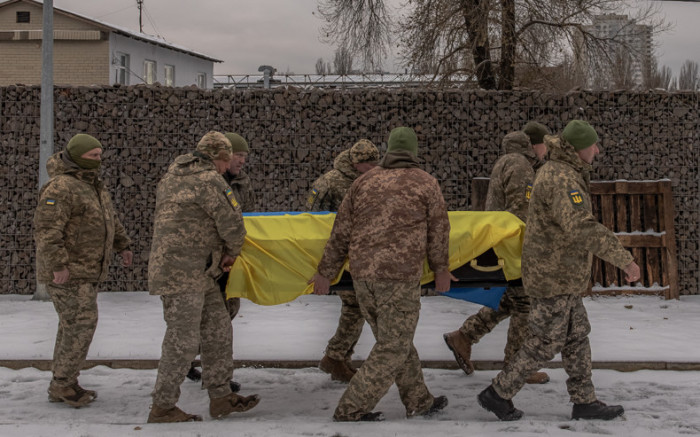
Peter Magubane, a black South African photographer whose images documenting the atrocities and violence of apartheid won global acclaim but faced punishment at home including beatings, imprisonment and 586 consecutive days of solitary confinement, died on Monday. He was 91.
His death was confirmed by family members speaking to South African television news broadcasts. No further details were disclosed.
The challenges and dangers faced by black photographers in the segregated apartheid-era townships of South Africa were so great, Mr. Magubane liked to say, that he hid his camera in hollowed-out loaves of bread, empty milk cartons or even the Bible, which is what it was enabled him to secretly take pictures.
“I didn’t want to leave the country to find another life,” he told The Guardian in 2015. “I wanted to stay and fight with my camera as a weapon.” But I didn’t want to kill anyone. I wanted to kill apartheid.”
He said he never staged images or asked permission to photograph people. “I apologize afterwards if anyone is offended,” he said, “but I want the picture.”
And he learned early in his career to put photography first. “I am no longer shocked,” he once said, “when I take photographs I am an unfeeling beast.” Only after I have completed my mission do I think of the dangers that surrounded me, of the tragedies that befell my people.”
The violence in the country took its toll in 1992 when his son Charles, also a photographer and then in his early 30s, was murdered in the sprawling black township of Soweto. Mr Magubane (pronounced mah-goo-BAHN-eh) blamed Zulu hostel dwellers for the murder.
“I have covered violence from the 1950s to today,” he said. “I never noticed it the way I noticed it now. Now it has hit my own door.”
He produced images of many of South Africa’s turning points, including the shooting of 69 unarmed protesters in Sharpeville in 1960, the Rivonia Trial Nelson Mandela and other leaders of the African National Congress in the early 1960s, as well as the Soweto high school students’ uprising in 1976. But when asked by the Guardian in 2015 to highlight his best photo, he opted for a calmer image.
The 1956 photo shows an anonymous black maid wearing a beret and apron tending to a young white girl on a bench marked “Europeans Only.”
It’s a poignant depiction of an era and a symbol of racial division that the maid appears to overcome while her white charge stares unfathomably into the camera.
“When I saw ‘European Only’ I knew I had to proceed with caution,” Magubane told The Guardian. “But I didn’t have a long lens, so I had to get close. However, I did not interact with the woman or the child. I never ask permission when taking photos. I worked in the midst of massacres where hundreds of people around me were killed, and you can’t ask for permission.”
During the same period he became friends with Nelson Mandela and his then wife. Winnie Madikizela Mandela. After Mr. Mandela was released from 27 years in prison in 1990, Mr. Magubane became his official photographer for four years until Mr. Mandela was elected South Africa’s first black president in 1994.
Mr. Magubane was often celebrated among a generation of black photographers whose skin color gave them access to segregated townships but provoked strong reactions from white police officers.
These photographers included Alf Khumalo And Sam Nzimawhose image of Hector Pieterson, a student killed in the 1976 Soweto riots, became one of the most powerful images of the revolt and the racial conflict that fueled it.
Much of the impetus for the advance of black photography came from a magazine called Drum, which reported on the abuses of apartheid, and its German-born chief photographer, Jürgen Schadeberg. Mr Magubane was so enthusiastic about joining the magazine that in 1954 he took a job as a driver and messenger before joining the photography department.
Increasingly he portrayed himself as part of the campaign to end white minority rule.
After many run-ins with the authorities, including five years under a so-called prohibition order that denied him the right to work or even be photographed or quoted, Mr. Magubane went into the Soweto riots “with my camera and all revenge.” he said said.
“Thanks to my photos, the whole world saw what happened,” he said.
When he arrived in Soweto that day, June 16, 1976, “young protesters did not allow us to take photos of them,” he told a university audience in South Africa in 2014.
He added: “I told them, ‘Listen, this is a fight; A fight without documentation is not a fight. Let them capture that, let them take photos of your fight; then you win.’”
He believed that whatever his role as a photographer, this did not preclude intervening to save lives.
Testifying before South Africa’s Truth and Reconciliation Commission in 1996, he said that on June 16 in Soweto a crowd tried to drag a man from his car. “I quickly stopped taking pictures, went over there and said, ‘This isn’t going to help your cause at all,'” he said. “Luckily this crowd listened; They listened to me and this man could go wherever he wanted to go.”
He also reported an incident involving an “infamous” green car from which two white police officers opened fire.
“Wherever there was shooting, if there was someone who needed help, I would become an ambulance man, pick up the body and take it to hospital if the person was still alive,” Mr Magubane told the commission.
“Sometimes my colleagues wanted to know if it was right for me to help because my job is photography,” he continued, “and I said that if my editor ever told me not to help – I shouldn’t help when it’s necessary – then my editor can go to hell.”
Peter Magubane was born on January 18, 1932 in the mixed-race area of Johannesburg known as Vrededorp. He grew up in Sophiatown, a cosmopolitan suburb that later became exclusively white and renamed Triomf, the Afrikaans word for triumph.
His father, Isaac, who sold vegetables to white customers from a horse-drawn cart, was a “tall, slender man with ‘colored’ features who spoke the oppressor’s language, Afrikaans,” Mr. Magubane wrote in a 1978 essay. One of the few times he spoke publicly about his family. In the apartheid lexicon, “colored” meant mixed race.
“My mother, Welhemina Mbatha,” he added, “was a jet-black woman who was proud of herself and was unwilling to let anyone bother her.”
Since his teenage years, Mr. Magubane had lived under the ever-increasing influence of apartheid – a pervasive network of racial laws that underpinned the strictly enforced separation of South Africa’s white, black, “colored” and Indian populations. The apartheid laws were so restrictive, he once said, that black photographers were not allowed to share darkrooms with white colleagues.
His interest in photography began when his father gave him a Kodak Box Brownie, although he says his first professional assignment – photographing an African National Congress conference in 1955 – was also done with a Japanese-made Yashica camera of his Father paid.
His career cost him his first marriage to Gladys Nala. Ms. Nala, he wrote, objected to his irregular work hours and the long nights he slept in the office because there was no way to return home. “So I had to choose between my career and my wife,” he wrote.
A second marriage in 1962 ended in divorce three years later. A third woman died of cancer in 2002. His survivors include a daughter, Fikile Magubane, and a granddaughter.
As protests spread, Mr. Magubane’s work in prison was interrupted by beatings and spells. Occasionally the security police made him stand on three bricks for five days and nights. He moved from Drum to The Rand Daily Mail, a liberal newspaper, and reported on the growing number of forced relocations as black communities were trucked into so-called “homelands” as part of apartheid’s vision of segregation.
After being held in solitary confinement for 586 days, he was released in 1970, only to be declared a prohibited person. The terms of his restriction meant he was not allowed to have contact with more than one other person at a time and was not allowed to enter a school or newspaper office for five years.
In his 1978 essay, Mr. Magubane gave a harrowing account of the effects of living “as a ghost for five years.”
“There was no one to talk to,” he said, “even my loved ones ran away like rats.”
He added: “My job as a newspaper photographer was over. It meant the end of my career.”
Even during Prohibition, he was sent back to prison in 1971 and served another 98 days in solitary confinement, followed by six months in prison.
During the entire time he was held under repressive laws ostensibly designed to combat communism and terrorism, “I was never convicted of a crime,” he said.
As the uprising unfolded in Soweto, he and other black journalists were detained, this time for 123 days, and his house was burned down. But his images of the uprising gained international recognition, including a job at Time magazine in South Africa in 1978. He then documented the riots, protests and states of emergency in the mid-1980s that led to Mr. Mandela’s release.
Over time, he published 17 books, exhibited widely, and received seven honorary degrees and numerous awards, including the prestigious Cornell Capa Infinity Award in 2010.
However, in his later years, as he battled prostate cancer, he focused more on sunsets than protest, telling The New York Times in 2012: “I’m tired of dealing with dead people. I’m working on sunsets now. You are so beautiful. You see so many; It’s like meeting beautiful women.”






Recent Comments